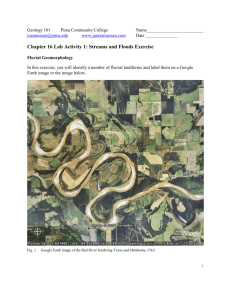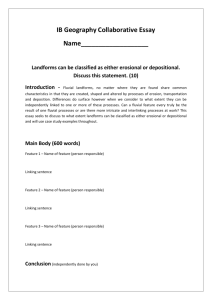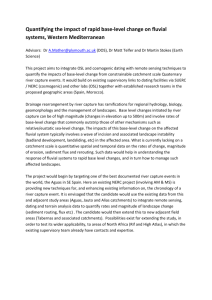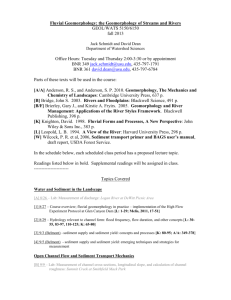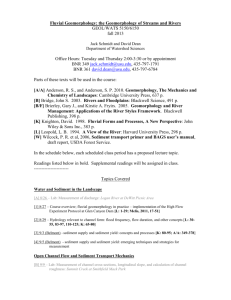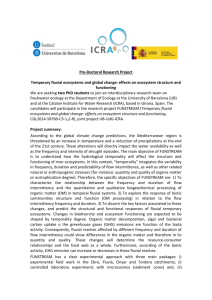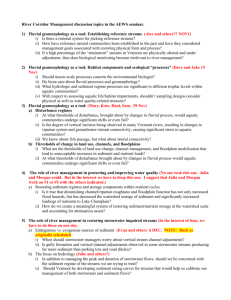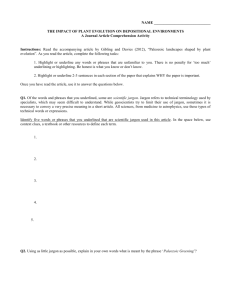QG&G Committee on Applied Fluvial Geomorphology
advertisement
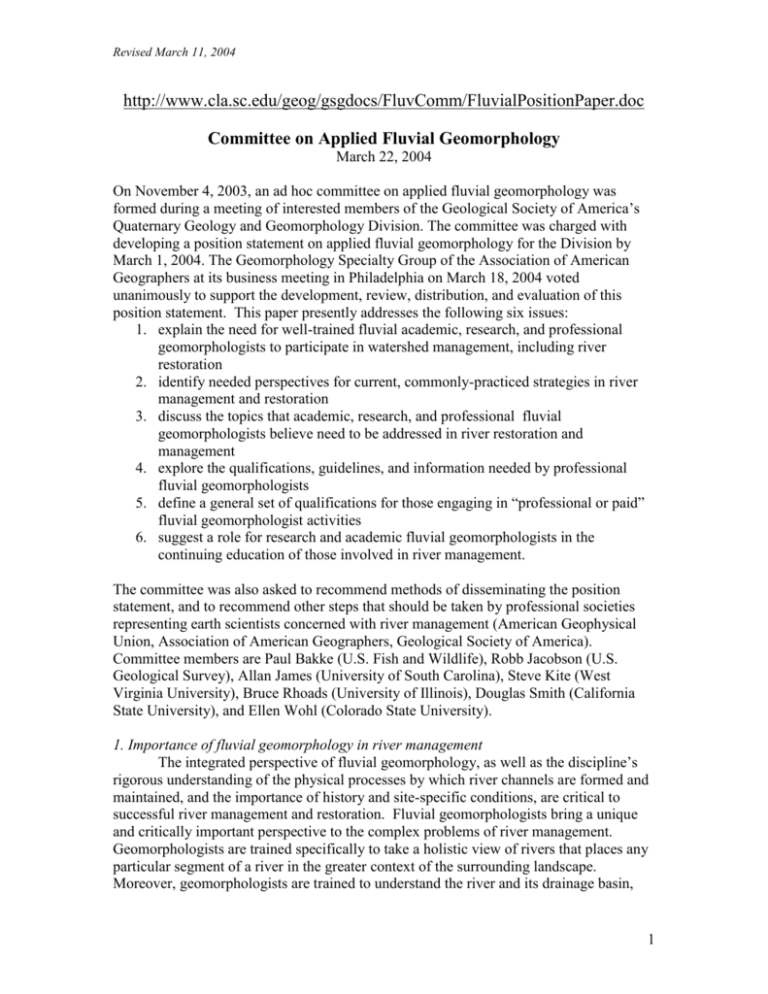
Revised March 11, 2004 http://www.cla.sc.edu/geog/gsgdocs/FluvComm/FluvialPositionPaper.doc Committee on Applied Fluvial Geomorphology March 22, 2004 On November 4, 2003, an ad hoc committee on applied fluvial geomorphology was formed during a meeting of interested members of the Geological Society of America’s Quaternary Geology and Geomorphology Division. The committee was charged with developing a position statement on applied fluvial geomorphology for the Division by March 1, 2004. The Geomorphology Specialty Group of the Association of American Geographers at its business meeting in Philadelphia on March 18, 2004 voted unanimously to support the development, review, distribution, and evaluation of this position statement. This paper presently addresses the following six issues: 1. explain the need for well-trained fluvial academic, research, and professional geomorphologists to participate in watershed management, including river restoration 2. identify needed perspectives for current, commonly-practiced strategies in river management and restoration 3. discuss the topics that academic, research, and professional fluvial geomorphologists believe need to be addressed in river restoration and management 4. explore the qualifications, guidelines, and information needed by professional fluvial geomorphologists 5. define a general set of qualifications for those engaging in “professional or paid” fluvial geomorphologist activities 6. suggest a role for research and academic fluvial geomorphologists in the continuing education of those involved in river management. The committee was also asked to recommend methods of disseminating the position statement, and to recommend other steps that should be taken by professional societies representing earth scientists concerned with river management (American Geophysical Union, Association of American Geographers, Geological Society of America). Committee members are Paul Bakke (U.S. Fish and Wildlife), Robb Jacobson (U.S. Geological Survey), Allan James (University of South Carolina), Steve Kite (West Virginia University), Bruce Rhoads (University of Illinois), Douglas Smith (California State University), and Ellen Wohl (Colorado State University). 1. Importance of fluvial geomorphology in river management The integrated perspective of fluvial geomorphology, as well as the discipline’s rigorous understanding of the physical processes by which river channels are formed and maintained, and the importance of history and site-specific conditions, are critical to successful river management and restoration. Fluvial geomorphologists bring a unique and critically important perspective to the complex problems of river management. Geomorphologists are trained specifically to take a holistic view of rivers that places any particular segment of a river in the greater context of the surrounding landscape. Moreover, geomorphologists are trained to understand the river and its drainage basin, 1 Revised March 11, 2004 and to develop predictive understanding from past behavior. Fluvial geomorphologists explicitly recognize that a river is intimately connected to adjacent hillslopes, floodplains, riparian corridors, hyporheic and groundwater zones; to upstream and downstream portions of the drainage basin; to the history of river and watershed dynamics; and to other components of the environment, such as atmospheric and biological systems. Any management activities that ignore these connections are likely to be unsuccessful and to cause unanticipated problems in adjacent areas. Fluvial geomorphologists are specifically trained to identify the relations between process and form along rivers, and to consider the possibility of thresholds, lag times, and complex response in river adjustment. Problems arise when river management focuses solely on river form, without considering the processes by which form is maintained. The integrated perspective of fluvial geomorphology, as well as the discipline’s rigorous understanding of the physical processes by which river channels are formed and maintained, and the importance of history and site-specific conditions, are critical to successful river management and restoration. Restoration of California’s Carmel River, for example, relied on planting riparian willows to stabilize the channel. The willows would have died without supplemental drip irrigation because pumping of the underlying aquifer since the 1960s had locally depressed the water table (Kondolf, 1996)— recognition of historic watershed conditions were essential for project success. Fluvial geomorphologists recognize a river as a physical system with a history. This history can indicate trends that result from past phenomena, and often places specific constraints on river behavior. Moreover fluvial geomorphologists recognize the high degree of variability in river behavior over a range of spatial scales from the local to the regional. Thus, geographic context and site-specific conditions are important considerations in understanding river behavior. They are trained to be careful field observers, and to be aware of the site-specific conditions that can cause an individual river to behave differently than suggested by general guidelines for river behavior. Understanding the site-specific condition is critical for effective investment of restoration funds, because structural measures that over-emphasize channel stability to improve aquatic habitat in disturbed zones of the channel are almost certain to fail. For example, placing drop structures at arbitrary distances along a low-gradient channel to create pools and riffles will likely result in bank erosion and lateral migration of the channel around the drop structures, because low-gradient channels are more likely to form pools where meandering creates scour along the outside of each meander bend. 2. Needed perspectives for commonly practiced strategies of river management We advocate an emphasis on and the recognition of (1) a process-based rather than descriptive understanding of fluvial dynamics, (2) magnitude-frequency relations and their connection to channel form and process (which encompasses the reference reach idea), (3) the critical importance of geographical context to proper understanding of river dynamics, and (4) the need for adequate documentation of river conditions before a project is implemented, and monitoring immediately and for a sustained period after project implementation to measure successes and failures and to understand the reasons behind both. Some applications of river classification and guidelines for river restoration by government agencies and consulting companies are misleading in their simplicity (for 2 Revised March 11, 2004 example, see Juracek and Fitzpatrick, 2003). These approaches are commonly used by individuals with little or no academic training in river processes, and give rise to four fundamental problems. (1) The classification systems are descriptive, and when used by practitioners with extensive experience and education in watershed science, can be used as one tool among many in watershed management, including channel/floodplain assessment and modifications. Problems arise when a descriptive classification system is used to assess channel stability and to predict future river behavior by under-educated practitioners who might not fully appreciate the complex processes that ultimately give a river/floodplain system its present morphology. A descriptive river classification system has merit for rapid communication of basic stream morphology. In general, morphology is the result of past processes. So, in theory one can read those past processes from descriptive stream classification. However, in most cases, streams are the result of a long history of watershed conditions, commonly involving both punctuated and chronic disturbances. In watersheds where disturbances are common, streams may be in a state of evolution, where the present morphology may be the result of the input from a complex combination of processes that only skilled fluvial geomorphologists can interpret. Thus practitioners who use descriptive stream categories without an understanding of the controls on river form or of how a river might respond to disturbance, are in a position to make poor predictions of stream response to future conditions and to make poor management decisions. Under this scenario, assigning a stream segment to a specific category gives the illusion of understanding and explanation but provides no insight into dynamic river processes and adjustment. Perhaps the greatest shortfall of a descriptive classification scheme and attendant management issues is the reliance on estimating “bankfull” stage in the channel. Most rivers have a channel and adjacent, relatively flat geomorphic surface. In only a subset of rivers is the break in slope between the channel and the adjacent flat easily related to geomorphic “bankfull”stage. An inexperienced or under-educated practitioner using descriptive stream classification as the basis for watershed management (inventories, assessments, monitoring, restoration) will undoubtedly be misclassifying streams on a regular basis. (2) Some restoration guidelines are based on the concept of a reference reach. The goal of the reference reach approach is to replace an impaired reach of river with a river/floodplain system having the morphology that the watershed above the impaired reach would produce under current conditions. The idea is to create a channel system that will undergo a minimum of physical adjustments to extant watershed conditions. This approach is analogous to planting a “climax” forest in an ecosystem restoration project instead of planting pioneer species and then waiting for the late-stage succession to evolve through time. To be most successful, this approach requires a firm understanding of the historic and present conditions in both the reference watershed and the watershed where restoration will occur. Great benefit would come from assessing the probable future conditions and likely stream response above and below the restored reach. Although not required for reference-reach work, stream classification can augment the approach by providing a quick means of summarizing and communicating channel and near-channel geometry. Problems may arise if an inexperienced practitioner 3 Revised March 11, 2004 puts too much reliance on the classification system without the regional watershed context. The approach requires assessing the stability of the reference reach under the same watershed conditions as the to be restored reach. Inexperienced practitioners might not recognize that the reference reach has its present morphology because of chronic disturbance in the reference watershed, or that the channel to be restored owes its impairment to chronic disturbance that could cause premature failure of the restored reach. For example, attempts to restore a river that has changed from a meandering to a braided form because of sediment inputs from historical placer mining will be unsuccessful if the sediment supply to the braided river continues to be high. (3) Lacking any but a superficial knowledge of river processes, and not being trained in field observation and interpretation, current paraprofessionals sometimes inappropriately apply guidelines or criteria developed for different types of streams than the stream under consideration. An example comes from a stream restoration project funded by the Maryland Department of Transportation along Deep Run Creek. Prior to restoration, Deep Run Creek had pools partially incised into weak bedrock, with cobble riffles between the pools. The creek was incised approximately 2 m below the surrounding floodplain, but was stable and had a dense riparian forest along its margins. Walking the creek during low flow, a consultant to the Maryland DOT decided that the riffle cobbles represented unstable deposits that indicated the stream had excess sediment. The creek was chosen for restoration, a process which involved removing the mature riparian forest, using heavy equipment to contour a sinuous channel into the floodplain, and then anchoring the meander bends with large logs sunken into the banks. During the first large flow following restoration, the banks eroded substantially, so that the artificially placed logs protruded from now-unstable cutbanks by 2 m or more. Finer sediment flushed into the channel from cutbank erosion increased turbidity, and was deposited along both pools and riffles. In this example, the consultant mistakenly interpreted riffle sediment exposed under seasonal low-flow conditions as evidence of excess sedimentation and channel instability. (4) Another fundamental problem with current river restoration projects is the lack of long-term monitoring to determine whether the techniques used to restore the river have been successful. This lack of monitoring over timescales of a year or longer makes it very difficult for paraprofessionals to learn from their mistakes; with a comprehensive background in geomorphology, professional geomorphologists recognize the need for monitoring and evaluation over timeframes consistent with the physical and biological adjustment processes of river systems. A recently published study of river restoration projects undertaken by the Civilian Conservation Corps during the 1930s indicates that structures which are still in common use today, including cover structures, grade-control structures, and channel modifications along the outside of meanders, produced negative results. In other words, these structures designed to enhance fish habitat by creating overhead cover, low-flow habitat, and bank stabilization, actually decreased these channel features over a period of decades (Thompson, 2002). 3. Topics essential to successful river management and restoration In the preceding sections we have detailed some of the problems that we believe exist in many current strategies of river management. The following list of topics that we 4 Revised March 11, 2004 believe need to be addressed in river management and restoration emphasizes the talents that well-trained, professional fluvial geomorphologists bring to these tasks. The valley context. Valleys where rivers flow come in a wide range of tectonic settings, substrates, climates, ecosystems, land-uses, sediment-supplies, widths, and gradients. Each local setting will impose a set of restrictions and opportunities for river management and restoration that an experienced practitioner will be able to recognize and exploit. The history of river form. River form reflects processes that have occurred at timescales ranging from the very short, such as the sequence of flows during the preceding decade, to much longer, such as continuing river response to base level rise following the stabilization of global sea levels six thousand years ago. Management and restoration activities that fail to recognize or attempt to contravene ongoing river responses are unlikely to succeed. The history of human activities within the drainage basin that influence river process and form. Most rivers around the world have undergone substantial changes in water and sediment discharge, and river pattern, as a result of forest clearing, agriculture, flow regulation, mining, urbanization, and other activities occurring within the drainage basin. These human activities date back more than five thousand years in some parts of the world, and less than a decade in other parts. Recognition of the continuing, and complexly interacting, responses of each river to changes in potential control variables, is critical when attempting to further manipulate river form and process. The close coupling between river form and process. Channel/floodplain restoration designs should be close in geometry to systems that are known to be relatively stable in the same watershed conditions. However, form reflects process, yet also influences process. Attempts to engineer form without considering how ongoing river processes will alter this imposed form following restoration cannot succeed without continual intervention and maintenance. Of critical importance is the link between channel geometry and sediment transport. Successful river channel design must incorporate an estimate of the sediment volume and sediment size that the channel is required to convey. Changes from a reference condition that cannot be altered. The lowered groundwater table in the Carmel River case study provides an example of a boundary condition affecting a river segment that cannot be easily altered or engineered, but which exerts a critical influence on the success of river engineering. The goals of management and restoration. The primary motivations behind river restoration are myriad; they include enhancement of fish habitat, stabilization of eroding streambed and banks, and aesthetic considerations. The goals may differ at each site. Some projects may be most effective by focusing on process, with form expected to change in response, whereas others focus on creating forms that will then influence process. A common ill-conceived goal in rehabilitation is to design a static, stable channel when the actual goal of restoration should be to restore ecosystem processes, a goal that requires a dynamic channel. Evolution of the river through time. As repeatedly emphasized above, successful restoration should not rely too heavily on an imposed, static form. Rivers are 5 Revised March 11, 2004 inherently dynamic, and restoration strategies should attempt to allow for continued river response to the initial restoration project, as well as to other potential changes (such as increasing urbanization) within the project watershed. Where protection of property from erosion or limited open space are issues, stabilization measures that prevent channel lateral migration may be necessary on a case-by-case basis. This should not be considered the standard remedy for most cases, however, and should be avoided when natural channel processes are feasible. Patience. The current reliance on heavy equipment and imposed river form, as well as the lack of ongoing evaluation of restoration projects, stems in part from the short timeframe and budget period of many projects. Successful management and restoration works with the river, rather than imposing too much, and allows for gradual and continuing response by the river to imposed changes. Monitoring. The best-intended river modifications might work or fail. Without careful pre-project and post-project monitoring, there is no benchmark for success and no opportunity for learning from one’s success or failure. Monitoring can also provide essential input leading to adaptive management practices that finetune restoration implementation. An adequate understanding of uncertainty. Rivers are complex systems, the behavior of which is difficult to generalize or to reduce to simple explanatory schemes. Professional geomorphologists should be aware of the full range of sources of uncertainty. In many cases, adequate understanding of even a single river system requires years of scientific research and even then surprises can occur. The high levels of uncertainty associated with river dynamics imply that management should proceed cautiously and should be based on information appropriate to the demand for achieving a desired outcome. 4. Information needed by practitioners of river management River restoration requires a team approach. Typical projects require input from geomorphologists, engineers, ecologists, and commonly other disciplines. Within this team framework, geomorphologists can contribute in a variety of ways, but their essential role is to contribute an understanding of the spatial and historical contexts of a stream within its watershed. The spatial context of the stream within the drainage basin determines in part how a project reach will be affected by changes elsewhere in the drainage basin – upstream and downstream – and the extent to which the project reach may be affected by these changes or ongoing adjustments of the system. Sustainable design of restoration projects requires experience and comprehensive understanding of the processes by which sediment and hydrologic disturbances can propagate through drainage basins. Historical understanding is critical to river restoration. Historical information derived from documentary and instrumental records, interpretation of aerial photography and analysis of surficial stratigraphy, is essential for developing an understanding of river dynamics. Historical assessment can define the sequence of past disturbances that have affected the drainage basin, indicate the extent of adjustment to those events, reveal past changes in environmental conditions that have led to fundamental alterations of river dynamics and provide the context for predictive understanding of future trends. In 6 Revised March 11, 2004 addition, professional geomorphologists have the comprehensive background needed to predict how future landuse/landcover changes are likely to affect managed reaches. 5. Background training to qualify as a fluvial geomorphologist The initiative to develop a position statement arises from concern that river management, and particularly river restoration, is currently being practiced by individuals who call themselves fluvial geomorphologists, yet have little formal training in the discipline. Demand for individuals trained in specific aspects of applied fluvial geomorphology is growing in the government and private sectors. A means to appropriately train and certify individuals without a prohibitive amount of course work would be of great benefit to these groups. As a consequence of demand for these skills, various paraprofessional training programs in fluvial geomorphology have been developed for application to stream classification, monitoring, assessment, management, and rehabilitation. In some cases, graduates of these paraprofessional training programs have been granted certificates that are being recognized by government agencies as evidence of expertise in the field of fluvial geomorphology, despite the lack of postprogram skills assessment. Although such training has clear benefits in educating students on the nature of rivers, many professional geomorphologists are concerned about the rigor and extent of this training compared to the comprehensive, multi-year, academic training undergone by professional geomorphologists. Training programs in applied fluvial geomorphology and a paraprofessional certificate program have merit for exposing professionals trained in other fields to fluvial geomorphology, but completion of such applied training programs does not impart the level of expertise obtained at multi-year university programs focusing on the science and practice of fluvial geomorphology. In sum, such certification is not equivalent to, nor can it be viewed as a substitute for training provided by academic programs. Moreover, the value of comprehensive approaches to fluvial geomorphology greatly exceeds that of paraprofessional training programs and should be recognized and incorporated into applied geomorphology. For example, applied approaches typically concentrate on the present condition of a channel at the reach scale, but channel adjustments usually reflect the integration of greater spatial (watershed) and temporal (historical) scales of fluvial processes. Geomorphology is the study of earth-surface processes and landforms, and fluvial geomorphology focuses specifically on river processes and landforms. The systematic study of physical processes in rivers goes back to at least the late 1700s, but most of the contemporary theory and practice in fluvial geomorphology dates from the second half of the twentieth century. During this period, individuals with formal academic training in geology, geography and civil engineering all made substantial contributions to fluvial geomorphology. Because of this inherently multidisciplinary history, fluvial geomorphology has never been identified exclusively with a single, traditional academic discipline. However, most geomorphologists who have been trained through multi-year academic programs are affiliated professionally with one or more of three organizations: the Hydrology Section of the American Geophysical Union, the Quaternary Geology and Geomorphology Division of the Geological Society of America, and the Geomorphology Specialty Group of the Association of American Geographers – the three groups involved in the production of this document. 7 Revised March 11, 2004 The multidisciplinary nature of the field makes it challenging to define a professional fluvial geomorphologist as someone who has completed a comprehensive core curriculum. In addition, research fluvial geomorphologists with different academic training commonly focus on different aspects of rivers. For example, someone with an academic training in geology might focus on the Quaternary history of rivers, as recorded in relict landforms and sedimentary records, whereas an individual trained in civil engineering with an emphasis on hydrology and hydraulics might focus on flow mechanics and sediment transport in contemporary rivers. We believe, however, that it is possible to define a core knowledge shared by all academically-trained, professional fluvial geomorphologists. This core knowledge includes, but is not limited to: undergraduate courses in physical geology; physical geography; Earth history; geomorphology; soils; hydrology; physics; calculus; statistics, and graduate courses in fluvial geomorphology, watershed processes, hillslope hydrology or geomorphology (taught within a geology, geography, or equivalent department); hydrology, hydraulics, and sediment transport (taught within a geology, geography, or civil/environmental engineering department); and quantitative analysis (statistics, mathematics, surveying, geographic information systems, remote sensing, and computational modeling). A well-trained professional fluvial geomorphologist will have some coursework from all of these core disciplines. An important point of emphasis is that fluvial geomorphology is a highly specialized field within the earth sciences that requires mastery of a considerable background body of background knowledge in geology, geography and hydrology. The aim of most undergraduate programs is to produce competent geomorphologists, not specialists in fluvial geomorphology. Specialization typically occurs at the graduate level when students are trained sufficiently to deal with the basic concepts inherent to understanding the complexity of fluvial processes and forms. The professional community of fluvial geomorphologists produced by universities almost invariably consists of individuals with either Masters degrees or PhD degrees in either the earth sciences (geology or geography) or hydrology (civil engineering). A vital component of this training is the completion of a Master’s thesis or PhD dissertation through engagement in independent research. Through the research experience, students are exposed first-hand to the complexities of river dynamics; to the appropriate application of their knowledge, experience and skills for basic and applied problems related to river dynamics; and to the limitations and levels of uncertainty associated with the study of river dynamics. 6. The role of fluvial geomorphologists in continuing education Limitations of existing paraprofessional training opportunities and strong demand for applied geomorphology services indicate a need for additional training opportunities. For many paraprofessionals, pursuit of formal university training is impractical; hence, there is a need for alternative venues that can still provide comprehensive geomorphology training. Training to support applied fluvial geomorphology should include a broad range of topics needed to develop comprehensive expertise. These should include: Historical analysis of watershed and channel responses. Development of historical reference conditions. 8 Revised March 11, 2004 Watershed analysis, including predictive hydrologic modeling of drainage basin responses. Application of geomorphic and hydrologic principles to restoration design. Application of ecological principles to restoration design. Sound understanding of the complexity, and levels of uncertainty inherent in the understanding of river dynamics Stream restoration is inherently interdisciplinary and must be taught in a venue that includes field, lab, and classroom context for optimal effect. Practical, hands-on experience in the educational process would require students to invest substantive amounts of time, probably at a particular facility or location. Some supporting curriculum may be usefully supplied in distance learning or internet environments, but the core of the curriculum will require a face-to-face educational experience. These curriculum requirements are conducive to the idea of a summer field camp, supported by a university or consortium of universities that could field a strong, and multidisciplinary team of educators. A critical difference between the educational experience described above and the current short-courses being offered in fluvial geomorphology is academic accountability. There are presently no well articulated learning outcomes, and most critical, no assessment of student learning in extant fluvial geomorphology short course forums. Conclusion Proper watershed management, including physical and biological modifications within the riparian corridor, is critical to developing sustainable water supplies and ecosystems, especially in the face of growing resource demand. This report is predicated upon the concern that both ecosystem and water quality health may be threatened by individuals, consulting firms, and various government agencies involved in permitting, funding, and performing professional river/floodplain assessments, modifications, and restorations without adequate academic or experiential depth and breadth. It is our position that the character and benefits of a comprehensive graduate education in fluvial geomorphology need to be better understood and appreciated. We seek to engage fluvial geomorphologists with broad post-baccalaureate university training in an effort to better define our discipline and to promote its strengths and attributes to the greater scientific and resource-management communities. Dissemination of position statement We will seek to publish the statement as a brief editorial in professional journals and newsletters, send it to state and federal agencies, and post it on the GSG, WRSG, and QG&G web sites. References Cited Juracek, K.E., and Fitzpatrick F.A., 2003, Limitations and implications of stream classification: Journal of the American Water Resources Association, v. 39, p. 659670. Kondolf, G.M. 1996. A cross section of stream channel restoration. Journal of Soil and Water Conservation 51: 119-125. 9 Revised March 11, 2004 Thompson, D.M. 2002. Long-term effect of instream habitat-improvement structures on channel morphology along the Blackledge and Salmon Rivers, Connecticut, USA. Environmental Management 29: 250-265. 10
